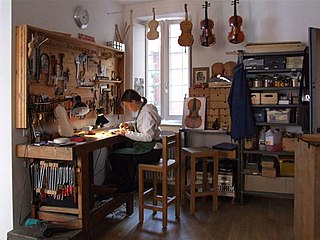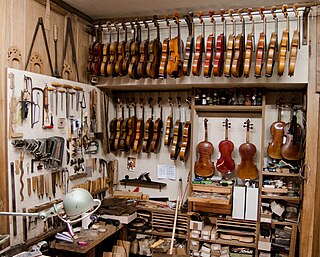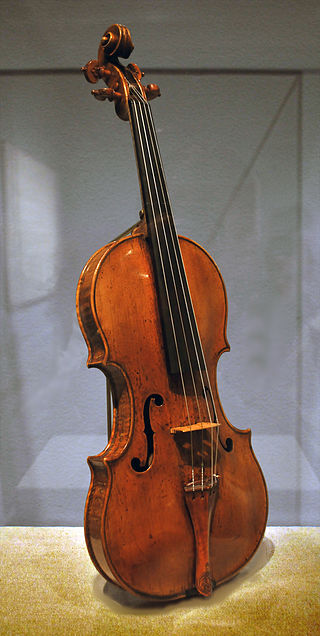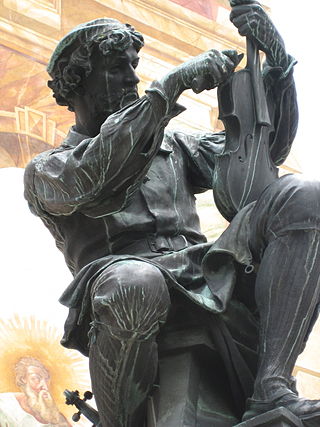
A luthier is a craftsperson who builds or repairs string instruments.

Les Luthiers is an Argentine comedy-musical group, very popular also in several other Spanish-speaking countries including Paraguay, Guatemala, Peru, Chile, Ecuador, Spain, Colombia, Mexico, Uruguay, Bolivia, Cuba, Costa Rica and Venezuela. They were formed in 1967 by Gerardo Masana, during the height of a period of very intense choral music activity in Argentina's state universities. Their outstanding characteristic is the home-made musical instruments, some of them extremely sophisticated, which they skillfully employ in their recitals to produce music and texts full of high class and refined humor. From 1977 until his death in 2007, they worked with Roberto Fontanarrosa, a renowned Argentine cartoonist and writer.
Jacob Stainer was the earliest and best known Austrian and Germanic luthier. His violins were sought after by famous 17th- and 18th-century musicians and composers including Johann Sebastian Bach, Wolfgang Amadeus Mozart and George Simon-Lohein. Arcangelo Corelli was one of many who played a Stainer violin.

Making an instrument of the violin family, also called lutherie, may be done in different ways, many of which have changed very little in nearly 500 years since the first violins were made. Some violins, called "bench-made" instruments, are made by a single individual, either a master maker or an advanced amateur, working alone. Several people may participate in the making of a "shop-made" instrument, working under the supervision of a master. This was the preferred method of old violin makers who always put their names on violins crafted by their apprentices. Various levels of "trade violin" exist, often mass-produced by workers who each focus on a small part of the overall job, with or without the aid of machinery.

The violin, viola and cello were first built in the early 16th century, in Italy. The earliest evidence for their existence is in paintings by Gaudenzio Ferrari from the 1530s, though Ferrari's instruments had only three strings. The Académie musicale, a treatise written in 1556 by Philibert Jambe de Fer, gives a clear description of the violin family much as we know it today.

Bartolomeo Giuseppe "del Gesù" Guarneri was an Italian luthier from the Guarneri family of Cremona. He rivals Antonio Stradivari (1644–1737) with regard to the respect and reverence accorded his instruments, and for many prominent players and collectors his instruments are the most coveted of all. Instruments made by Guarneri are often referred to as Del Gesùs.

Mirecourt is a commune in the Vosges department in Grand Est in northeastern France. Mirecourt is known for lace-making and the manufacture of musical instruments, particularly those of the violin family.

Mittenwald is a German municipality in the district of Garmisch-Partenkirchen, in Bavaria.
Samuel Zygmuntowicz is a contemporary luthier and is widely regarded as one of the finest violin makers of his generation. He began his instrument making training at age 13, and studied making and restoration under Peter Prier, Carl Becker and René Morel. Since 1985 he has been based in Brooklyn, New York. His early work demonstrates expert skill as a copyist of classic instruments. Later work includes personal models informed by intensive advanced research. Findings from this research have been published in numerous print and digital media. Zygmuntowicz is an active fiddler, playing with several folk music groups. His playing can be heard on the recordings Grand Picnic, and Jump When the Trumpets Blow.
Gregg T. Alf is a prominent contemporary American violin maker based in Ann Arbor, Michigan.
Caressa & Français was a distinguished firm in Paris that specialized in fine musical instruments and bows.
John Juzek(néJanek Jůzek, akaJan, akaJohann;1892, Písek – c. 1965, Luby) was a Czech merchant, widely known in North America as an exporter of violins, violas, cellos, and double basses made and labeled under his anglicized name, "John Juzek," crafted mostly by guilds and various independent makers in the Bohemia region of the Czechoslovakia and Germany border.

Nicola Amati, Nicolò Amati or Nicolao Amati was an Italian master luthier from Cremona, Italy. Amati is one of the most well-known luthiers from the Casa Amati. He was the teacher of illustrious Cremonese School luthiers such as Andrea Guarneri and Giovanni Battista Rogeri. While no clear documentation exists for their being apprentices in his shop, Amati may also have apprenticed Antonio Stradivari, Francesco Rugeri, and Jacob Stainer, as their work is heavily influenced by Amati.

Andrea Amati was a luthier, from Cremona, Italy. Amati is credited with making the first instruments of the violin family that are in the form we use today. Several of his instruments survive to the present day, and some of them can still be played. Many of the surviving instruments were among a consignment of 38 instruments delivered to Charles IX of France in 1564.

Matthias Klotz (1653–1743) was German luthier, a member of the Klotz family of violin makers that flourished in Mittenwald, Germany as early as 1683.
The Cheb Violin Making School is a public school in Cheb in the Czech Republic. It is the outgrowth of the Imperial-Royal Music School, a one hundred and fifty-one-year-old institution, located — from inception on 1 August 1873 until 2005 — in Luby. In 2005, the school moved to Cheb. It is the only surviving violin-making school in the country, and one of five in all of Europe. Luby had been, and still is a town rich in tradition of generations of violin-making dating back to the sixteenth century.
Guillaume Max Möller(akaMax Jr.; 1915–1985 Amsterdam) was a Dutch master luthier from Amsterdam who authored a seminal reference book, The violin-makers of the Low Countries (1955) OCLC 251291325 Möller also provided the illustrations.

Carl Fredrick Becker was an American luthier and restorer, known for restoring the "Lady Blunt" 1721 Stradivarius violin. He had a reputation as "one of America's finest violin makers" and “the dean of American violin-making”.

Roy Courtnall (born Roy Shapiro) artist (painter and sculptor), luthier, author, teacher and lecturer in musical instrument technology.

Guy Rabut is an American luthier based in New York City.















